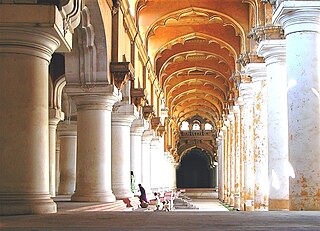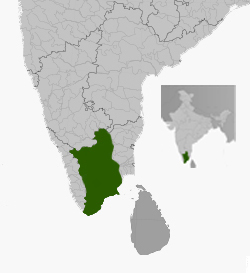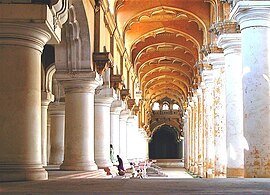
The Carnatic region is the peninsular South Indian region between the Eastern Ghats and the Bay of Bengal, in the erstwhile Madras Presidency and in the modern Indian states of Tamil Nadu and southern coastal Andhra Pradesh. During the British era.

Chhatrapati is a royal title from Sanskrit used to denote a monarch or imperial head of state. The word "Chhatrapati" is a Sanskrit language compound word of chhatra and pati (master/lord/ruler). This title was used by the House of Bhonsle, between 1674 and 1818, as the heads of state of the Maratha Confederacy.

Rani Mangammal was a queen regent of the Madurai Nayak kingdom during the minority of her grandson Vijaya Ranga Chokkanatha in 1689—1704. She was a popular administrator and is still widely remembered as a maker of roads and avenues, and a builder of temples, tanks and choultries with many of her public works still in use. She is also known for her diplomatic and political skills and successful military campaigns. The capital of Madurai Kingdom during her times was Tiruchy.

The Thanjavur Nayakdynasty were the rulers of Thanjavur in the 15th and 17th centuries. The Nayaks, who belonged to the Telugu-speaking Balija social group were originally appointed as provincial governors by the Vijayanagara Emperor in the 15th century, who divided the territory into Nayak kingdoms which were Madurai, Tanjore, Gingee and Kalahasthi. In the mid-15th century they became an independent kingdom, although they continued their alliance with the Vijayanagara Empire. The Thanjavur Nayaks were notable for their patronage of literature and the arts.
The Balija are a Telugu-speaking trading community primarily living in the Indian states of Andhra Pradesh, Tamil Nadu, Karnataka and in smaller numbers in Telangana and Kerala. Balijas are known as Banajigas in Karnataka.

The Carnatic Sultanate was a kingdom in South India between about 1690 and 1855, and was under the legal purview of the Nizam of Hyderabad, until their demise. They initially had their capital at Arcot in the present-day Indian state of Tamil Nadu. Their rule is an important period in the history of the Carnatic and Coromandel Coast regions, in which the Mughal Empire gave way to the rising influence of the Maratha Empire, and later the emergence of the British Raj.

Chanda Sahib was a subject of the Mughal Empire and the Nawab of the Carnatic between 1749 and 1752. Initially he was supported by the French during the Carnatic Wars. After his defeat at Arcot in 1751, he was captured by the Marathas of Thanjavur and executed.

The Nayaks of Kandy were the rulers of the Kingdom of Kandy between 1739 and 1815, and the last dynasty to rule on the island. The term Nayak is derived from the Sanskrit word Nāyaka. Their rise to power came about as a result of the death of Vira Narendrasinha, who left no legitimate heir- the throne passed to his brother-in-law, who was crowned as Sri Vijaya Rajasinha in 1739. They were of Telugu Balija origin, spoke Telugu and Tamil, and used Sinhala and Tamil as their court languages. They are also credited for building various Vishnu temples in Sri Lanka dedicated to their clan deity Vishnu, known as Upulvan in Sinhala. A prominent one of them was the Kandy Vishnu Temple established at their capital Kandy. A cadet branch of the Madurai Nayak dynasty, the Kandyan Nayaks were related to the Thanjavur Nayaks as well. Both Madurai and Thanjavur nayaks belonged to Balija caste.
Bangaru Thirumala Nayaka, also known as Bangaru Tirumala and Vangaru Thirumala, was a member of Madurai Nayak royal family and Governor/Commander of the Madurai Nayak King Vijaya Ranga Chokkanatha (1704–1731). His son, a young boy was adopted and crowned to the Madurai Throne, with the queen Meenakshi as queen regent, when the Madurai king died without heir. Strife between Bangaru Thirumala and queen Meenakshi would later erupt into many battles leading to the downfall of the dynasty. Later, through marriage alliances with the Sinhalese royalty, relatives of Bangaru Thirumala came to rule the Kandy kingdom in Sri Lanka. They ruled till 1815 when the last king, Sri Vikrama Rajasinha was deposed and taken captive by the British. He was exiled to Vellore Fort from Kandy.

The Madurai Nayaks were a Telugu dynasty who ruled most of modern-day Tamil Nadu, India, with Madurai as their capital. The Madurai Nayaks had their origins in the Balija warrior clans of present-day Andhra Pradesh. The Nayak reign which lasted for over two centuries from around 1529 to 1736 was noted for its achievements in arts, cultural and administrative reforms, revitalization of temples previously ransacked by the Delhi Sultans, and the inauguration of a unique architectural style.

Vyankojirajah Bhonsle or Ekojirajah I Bhonsle was the younger half-brother of Chhatrapati Shivaji Maharaj and founder of Maratha rule in Thanjavur in modern day Tamil Nadu. He was the progenitor of the junior branch of the Bhonsle family which ruled Thanjavur until the formal annexation of the kingdom by the British East India Company in 1855.

The Thanjavur Maratha kingdom ruled by the Bhonsle dynasty was a principality of Tamil Nadu between the 17th and 19th centuries. Their native language was Thanjavur Marathi. Venkoji was the founder of the dynasty.

Vimaladharmasurya II was a peaceful king of Kandy who succeeded his father, Rajasinghe II, on December 7, 1687.

Viswanatha Nayak was the Vijayanagara viceroy to Madurai in south India during the 16th century. He later became the ruler of Madurai after the fall of the Vijayanagara empire. He is the founder of the Nayak dynasty of Madurai. He hailed from the Garikepati family of Balija caste.
Sriman Hiranyagarbha Ravikula Raja Muthu Vijaya Raghunatha Raja Raghunatha Deva Kilavan Setupati was the first king of Ramnad Kingdom which is also known "Maravar Kingdom". He ruled from 1673 to 1708 and oversaw the growth of the feudal chieftainship of Ramnad into a powerful "Ramnad Kingdom" which is known as "Maravar Kingdom". He rescued the Nayak of Madurai from the tyranny of Rustam Khan and also successfully campaigned against the King of Thanjavur, who later ceded all his territories. It is recorded in the Sethupati copper plates that he belonged to the Surya kulam and Kashyap gothram.

The Kingdom of Ramnad or Ramnad estate was a permanently settled kingdom and later zamindari estate that existed in the Ramnad subdivision of the Madurai district and later Ramnad district of the erstwhile Madras Presidency in British India from 1601. It was ruled by the rajas also had the title of Sethupathi. Madurai Nayaks ruled the Ramnad area with the appointed chieftains between 14th to 16th century CE, and in 17th century CE the appointed governors expanded their power to establish "Ramnad Kingdom" which was also called as "Maravar Kingdom" by the British. In 1795 CE, after an heir dispute, they were reduced to the status of zamidari by the East India Company. After the independence of India in 1947 the estates were merged in the Union of India and in 1949 all rulers lost the ruling rights, privy purse was also finally abolished in 1971.
Meenakshi is a Hindu goddess, sometimes considered an avatar of the goddess Parvati.
The Trichinopoly district was a district of the erstwhile Madras Presidency of British India. It covered the present-day districts of Tiruchirappalli, Karur, Ariyalur and Perambalur in the Indian state of Tamil Nadu. The administrative headquarters was the town of Trichinopoly, Trichy or Tiruchi, now known as Tiruchirappalli. The district covered an area of 2,632 square miles (6,820 km2) in 1907. It was bound by the districts of South Arcot to the north, Salem to the west, Coimbatore to the west and north-west, Tanjore to the east and Madurai to the south. The princely state of Pudukkottai remained within the jurisdiction of Trichinopoly district from 1865 to 1947.

Tiruchirappalli is believed to be of great antiquity and has been ruled by the Early Cholas, Mutharaiyars Early Pandyas, Pallavas, Medieval Cholas, Later Cholas, Later Pandyas, Delhi Sultanate, Ma'bar Sultanate, Vijayanagar Empire, Nayak Dynasty, the Carnatic state and the British at different times. The archaeologically important town of Uraiyur which served as the capital of the Early Cholas is a Neighborhood of Tiruchirapalli.
Vijaya Raghava Nayak was the fourth and last king of Sevappa Nayak's line. He ruled from 1634 to 1673. In 1673, Vijaya Raghava Nayak was defeated in battle by the Madurai Nayak king Chokkanatha Nayak who captured and beheaded him.













